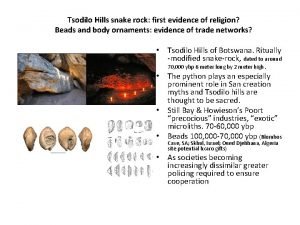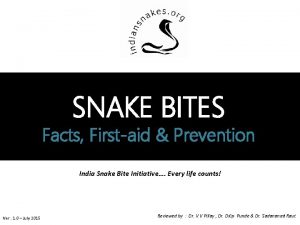Tsodilo Hills snake rock first evidence of religion
















- Slides: 16

Tsodilo Hills snake rock: first evidence of religion? Beads and body ornaments: evidence of trade networks? • Tsodilo Hills of Botswana. Ritually -modified snake-rock, dated to around 70, 000 ybp 6 meter long by 2 meter high. • The python plays an especially prominent role in San creation myths and Tsodilo hills are thought to be sacred. • Still Bay & Howieson’s Poort “precocious” industries, “exotic” microliths. 70 -60, 000 ybp • Beads 100, 000 -70, 000 ybp (Blombos Cave, SA; Skhul, Israel; Oued Djebbana, Algeria site potential hxaro gifts) • As societies becoming increasingly dissimilar greater policing required to ensure cooperation

Bruniquel Cave (France) vs. Rhino Cave (Tsodilo Hills, Botswana) Neanderthal and Homo Sapiens’ Cave Rituals Tsodilo Hills, central Botswana, from a distance Bruniquel: all materials used found in the cave • • Rhino: exotic materials brought to the cave and burned and destroyed in ritual activity Rhino cave rituals higher “cost”

UP religion • Les Trois Freres “Sorcerer” image • Bird-man image from shaft at Lascaux • Both dated to Magdalenian era 18, 00012, 000 ybp

UP Painted Caves Chauvet Cave 30, 000 ybp

Altamira 16, 000 ybp

Lascaux 16, 000 ybp

• Early UP evidence of religion – Sungir burial 28, 000 ybp – Hohlenstein-Stadel “lion-man” 30, 000 ybp – Fumane Cave “shaman” 35, 000 ybp

Supernatural value monitoring: Gods who care • Earliest forms of religion represented supernatural layer to social life – Animism: personalizing the natural world – Shamanism: mediating between the natural and supernatural – Ancestors: guardians of tradition and taboo Humans always behave better when being watched, a supernaturalized social world is one with constant monitoring. Human relationships and community “elevated” by presumed value monitoring

Why “supernaturalize” social life? • Group benefits – Supernaturalized rituals more effective in promoting group cohesion and trust – Orthodox kibbutz, religions communes more cohesive, enduring, individuals more selfsacrificing compared to secular. – Group competition likely in ancestral past (64% engaged in regular group warfare; only 11% “peaceful”)

Ritual and norm following • Following norms of: - in-group cooperativeness - self-restraint - commitment in marriage - honesty - charity All positively correlated in increased ritual activity Support for extreme form of norm-following, parochial altruism, crossculturally associated with increased ritual participation (Ginges, et al. , 2009). Experimental study (Wiltermuth & Heath, 2009); those who participated in group-coordinated; synchronized activities more cooperative and generous later (“muscular bonding”)

Heeding the message: Creating complex societies through social norms • Only humans have social norms • Chimps are “rational maximizers” in “dictator” games; no third party punishment among chimps • Social norms vs. conventions – Conventions: rules for coordinating activity – Morally weighty social rules that all are “ought” to follow (character, reputation, social standing, and social sanctions determined by norms). – Con: raising hands to be recognized – Norm: respecting elders, repaying debts etc.

Why did Cro-Magnons replace Neanderthals? • • • Cognitive differences alone seem inadequate Cooperative Hunting (Le Cotte) Worked beads/pendants (Arcy sur Cure) Art? (La Roche-Cotard mask) These finds are relatively rare

Consistent social differences • Cro-Magnon sites consistently larger, more frequent, more spatially organized (sometimes), more intensely used and occupied, higher population densities, greater seasonal aggregation. • Evidence of long-distance trading networks

Stronger Social Identity • First evidence of body ornaments sometime between 100 -70, 000 ybp. • Emergence of durable social marking • Expansion of Parietal lobe – greater capacity for social categorization. • “Troop to tribe” transition

An older generation • Caspari and Lee (2004) analyzed tooth samples from Australopiths, Early Homo, Neanderthals, and Cro-Magnons. • Older/Younger adults (Older = 2 X average of reproduction) • A=. 12; EH=. 25; N=. 39; C-M=2. 08. • Only among UP modern humans was there evidence of an older generation.

Effects of an Older Generation • Greater security and stability: more eyes to watch children, more hands to procure resources. • Cultural continuity: traditions, skills more effectively passed on, stronger cultural identity. • Social role specialization: domestic/economic tasks can be more effectively spread among adult group members. Sexrole specialization.
 Tsodilo hills snake
Tsodilo hills snake Igneous rock to metamorphic rock
Igneous rock to metamorphic rock Western religion vs eastern religion
Western religion vs eastern religion Dome of the rock religion
Dome of the rock religion How can one type of rock change into another type of rock?
How can one type of rock change into another type of rock? Igneous rock to metamorphic rock
Igneous rock to metamorphic rock Adventure sports bungee jumping
Adventure sports bungee jumping A rock climber's shoe loosens a rock and her climbing buddy
A rock climber's shoe loosens a rock and her climbing buddy A rock climber's shoe loosens a rock and her climbing buddy
A rock climber's shoe loosens a rock and her climbing buddy Rock cycle labeled
Rock cycle labeled A whalebone that originally contained 200 grams
A whalebone that originally contained 200 grams What is primary sources
What is primary sources Primary evidence vs secondary evidence
Primary evidence vs secondary evidence Secondary sources
Secondary sources Primary evidence vs secondary evidence
Primary evidence vs secondary evidence Jobs vancouver
Jobs vancouver Are fibers class evidence
Are fibers class evidence































